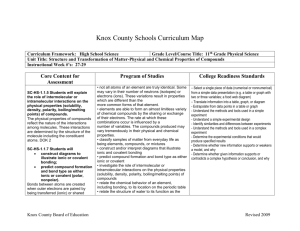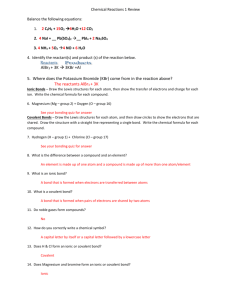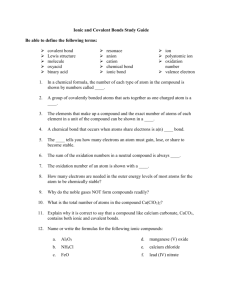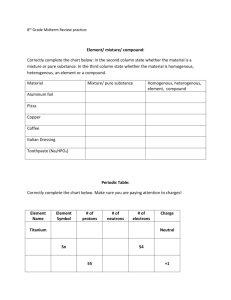Chapter 6 Practice Test: Chemical Bonding
advertisement
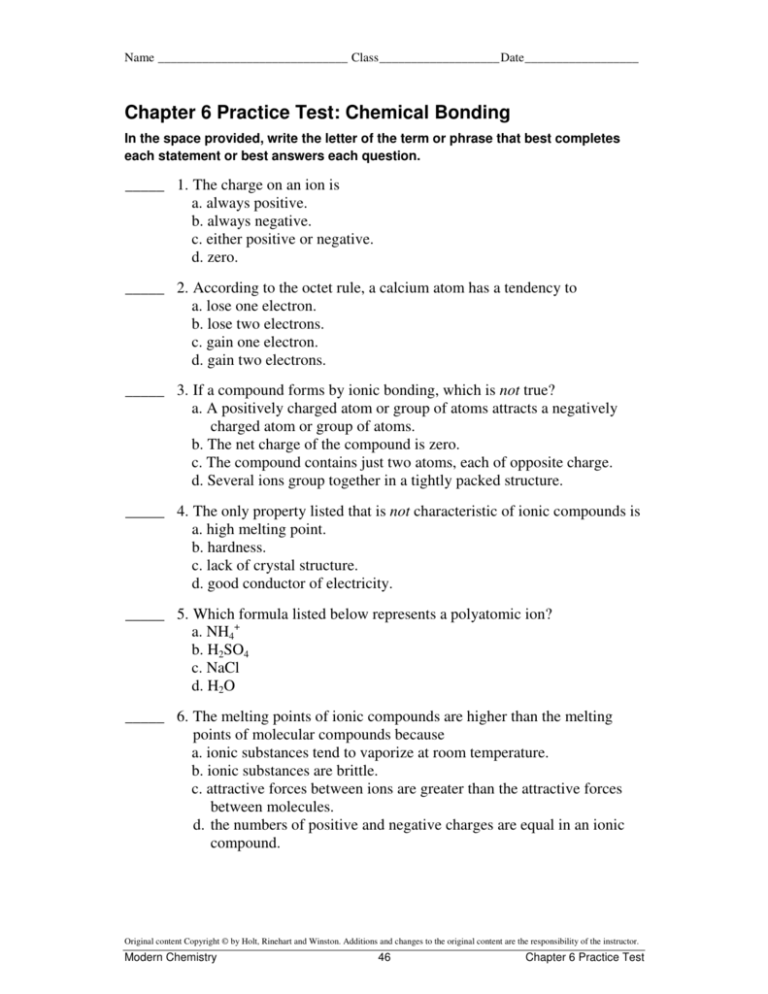
Name ______________________________ Class ___________________ Date __________________ Chapter 6 Practice Test: Chemical Bonding In the space provided, write the letter of the term or phrase that best completes each statement or best answers each question. _____ 1. The charge on an ion is a. always positive. b. always negative. c. either positive or negative. d. zero. _____ 2. According to the octet rule, a calcium atom has a tendency to a. lose one electron. b. lose two electrons. c. gain one electron. d. gain two electrons. _____ 3. If a compound forms by ionic bonding, which is not true? a. A positively charged atom or group of atoms attracts a negatively charged atom or group of atoms. b. The net charge of the compound is zero. c. The compound contains just two atoms, each of opposite charge. d. Several ions group together in a tightly packed structure. _____ 4. The only property listed that is not characteristic of ionic compounds is a. high melting point. b. hardness. c. lack of crystal structure. d. good conductor of electricity. _____ 5. Which formula listed below represents a polyatomic ion? a. NH4+ b. H2SO4 c. NaCl d. H2O _____ 6. The melting points of ionic compounds are higher than the melting points of molecular compounds because a. ionic substances tend to vaporize at room temperature. b. ionic substances are brittle. c. attractive forces between ions are greater than the attractive forces between molecules. d. the numbers of positive and negative charges are equal in an ionic compound. Original content Copyright © by Holt, Rinehart and Winston. Additions and changes to the original content are the responsibility of the instructor. Modern Chemistry 46 Chapter 6 Practice Test Name ______________________________ Class ___________________ Date __________________ _____ 7. A covalent bond is formed when two atoms a. share an electron with each other. b. share one or more pairs of electrons with each other. c. gain electrons. d. gain and lose electrons. _____ 8.Two atoms will likely form a polar covalent bond if the electronegativity difference is a. 0.1. b. 1.0. c. 2.5. d. 4.0. _____ 9. In which of these compounds is the bond between the atoms not a nonpolar covalent bond? a. Cl2 b. H2 c. HCl d. O2 _____ 10. As the electronegativity difference between bonded atoms decreases, the bond becomes more a. covalent. b. ionic. c. metallic. d. Both (b) and (c) _____ 11. Lattice energy is an indication of the a. strength of an ionic bond. b. number of ions in a crystal. c. strength of a metallic bond. d. strength of a covalent bond. _____ 12.Which is the correct Lewis structure for SiF4? a. b. c. d. Original content Copyright © by Holt, Rinehart and Winston. Additions and changes to the original content are the responsibility of the instructor. Modern Chemistry 47 Chapter 6 Practice Test Name ______________________________ Class ___________________ Date __________________ _____ 13.Which is the correct Lewis structure for C2H4? a. b. c. d. PART II Write the correct term (or terms) in the space provided. 14. A covalent bond in which the bonded atoms have an unequal attraction for the shared electrons is called a(n) _______________________. 15. A molecule containing two atoms is called a(n) _______________________. 16. The degree to which bonding between atoms of two different elements is ionic or covalent can be determined from the differences in the _______________________ of the elements. 17. A neutral group of atoms held together by covalent bonds is called a(n) _______________________. 18. The electron dot notation for a neon atom is _______________________. 19. A shorthand representation of the composition of a substance using atomic symbols and numerical subscripts is called a(n) _______________________. 20. A charged group of covalently bonded atoms is called a(n) _______________________. 21. A covalent bond between two atoms produced by sharing two pairs of electrons is called a(n) _______________________. 22. The simplest collection of atoms from which the formula of an ionic compound can be established is called a(n)_______________________. 23. A chemical bond that results from the attraction between metal atoms and the surrounding sea of electrons is called a(n) _______________________. 24. The property of being able to be drawn, pulled, or extruded through a small opening to produce a wire is called _______________________. Original content Copyright © by Holt, Rinehart and Winston. Additions and changes to the original content are the responsibility of the instructor. Modern Chemistry 48 Chapter 6 Practice Test Name ______________________________ Class ___________________ Date __________________ PART III Draw the Lewis structures for the following substances in the space provided. Use VESPR theory to predict the molecular shape of the following molecules. 25. nitrogen molecule, N2 28. phosphorous trihidride, PH3 26. hydrogen chloride, HCl 29. boron trichloride, BCl3 27. carbon tetraiodide, CI4 30. water molecule, H2O PART IV Use electron-dot structures to show the formation of ionic compounds involving the following elements. Label cation and anion. 31. Na and S 32. Ca and Cl PART V Classify each compound as ionic or covalent. 33. Water (H2) _____________________________ 34. Sulfur dichloride (SCl2) ______________________________ 35. Magnesium chloride (MgCl2) ____________________________ 36. Iron (II) oxide (FeO) ______________________________________ Original content Copyright © by Holt, Rinehart and Winston. Additions and changes to the original content are the responsibility of the instructor. Modern Chemistry 49 Chapter 6 Practice Test

